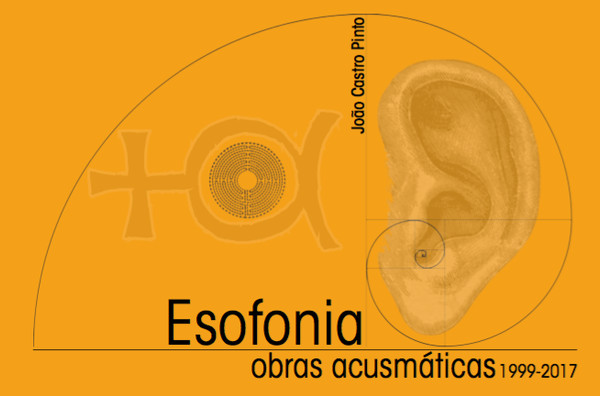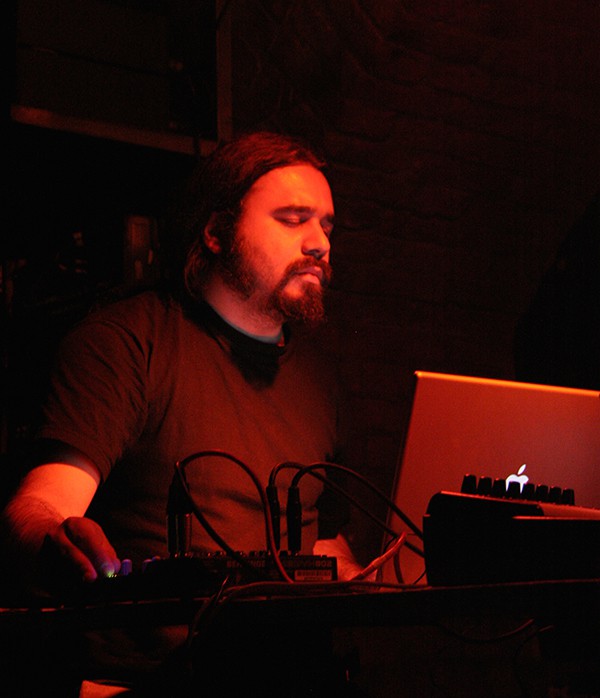
João Castro Pinto
Esofonia - obras acusmáticas 1999-2017
Album PT 2017 on Miso Records label
Electronic (Experimental, Abstract, Musique Concrète)
Esofonia is an anthology of acousmatic pieces that illustrates part of the musical journey of João Castro Pinto (from 1999 to 2017). Although they are referred to as acousmatic, the works that appear here are, more precisely, of a hybrid nature, i.e., they vary drastically, in terms of quantity and quality, between the maximally acousmatic and the totally referential. Nevertheless, the term was used because, in the structural conception of all the compositions, a work of pronounced decharacterization of the used sound sources as raw material is notorious. The creative use of silence, the interest in exploring unusual timbres, the intensive exploration of dynamics and gestures, the use of experimental compositional methods are qualities that stand out in João Castro Pinto’s music. I dedicate this anthology, with friendship and deep admiration, to the Composer, Poet & Performer Miguel Azguime, whose noble example of commitment, dedication and quality should inspire and guide us towards the exponential development of our Artistic and Human potential. special thanks: Miguel e Paula Azguime, Rogério Pinto, Maria João Pinto, Sofia A. Carvalho, Paulo Urbano Carvalho, Joana Serrão e Pedro Romano. ............................................. Esofonia - obras acusmáticas 1999-2017 SYNOPSIS Impressões Sintéticas - 04:43 (1999) * composed in a private studio. selectes and premiered by the Jovens Criadores 1999 contest - Lisboa Portugal. * [excerpt] This piece was produced in August 1999, and its composition was achieved through two fundamental procedures: 1st- gathering eld recordings via Mini Disc, 2nd - edition, processing and organization of the sounds. Some audio processing was performed on a Macintosh laptop (via Metasynth software), being the remaining signal processing and composition performed by a Pentium (166Mhz CPU and 64 mb RAM) using Wavelab 2 and Sound Forge 4 software. The compositional process of organizing the sounds was performed by Sound Forge software editor, onto a single stereo track, creating successive mixes (approx. 1000 for the 15 minutes of the piece), because the computer in question didn ́t had a DAW installed. Founded on the idea of synthesis, i.e., in an operation that starts from the simple to the complex, in the unity obtained by the movement and dialectical integration of contradictory elements, Impressões Sintéticas presents itself as composition that counts with concrete, electronic and electroacoustic sounds. Throughout three parts, natural acoustic spaces are presented in concomitance with textures and gestures that do not exist in the everyday sonic environment, quasi-cinematic fragments, which are vividly seeking to represent the fundamental contradiction between the social, material and technological progress of Humanity and Life, while understood from an ecological perspective, that is, not anthropocentric. Impressões Sintéticas intends to refer us to the "unreal" facticity of synthetic sounds, by suggesting ambiguous sound images interwoven by the dynamic play of sounds of natural and synthetic origin, invites us to make a re ection on the states of human consciousness and evolution in the context of a world that is increasingly distancing itself from its origin. * due to technical constraints that are insurmountable, we present only a excerpt of the piece. ---------------------------------------------------------------------------- Invocatio - ascribing soundimages into silence - 04:44 (2009) composed in a private studio. electroacoustic miniature selected and premiered at the “Soundwalk” installation of Música Viva Festival 2009, C.C.B. - Lisbon Portugal. rst edition on the album:“PANAURAL - interspersed soundwalks and soundscapes” (2012), by Triple Bath (Greece). Invocatio is based on the idea of invocation (from the Latin invocatio / invocare), as an act of desiring and praying for the presence, on the profane plane, of the sacred arché (ἀρχή), the unveiling of the Primeval Principle. This piece is inspired in Goethe's great work: Faust, and intends to establish itself as a small tribute to the majestic and complex hermetic symbolism that is encrypted in this work, which surprises us, and directs us to experience inner silence. Far from being a piece that assumes itself as having a gurative narrative (via sonic aesthesis) concerning the work's contents, the work which is here presented constitutes an electroacoustic miniature that recreates environments and moments, that reveal transmutable and quasi-alchemical sound-plots, accordingly with the main purpose of Dr. Faust : the call for the mysterious beyond, the thirst for interior knowledge, the intent to contact the Self and, moreover, a profound wish for initiation and to get the Lapis Philosophorum. ---------------------------------------------------------------------------- Interspersed Memories: on strings, murmurs & gongs – 8:23 (2012) composed in a private studio. selected and premiered in S.I.C.M.F. - Seoul International Computer Music Festival 2012 - Seoul South Korea. rst edition on the album "ARS ABSCONDITA" (2013), by OtO (Japan). Interspersed Memories: on strings, murmurs & gongs is piece based on the sounds of string instruments (piano, santur and berimbau), murmurs (hindu chimes, bells and electronic synthesis) and Tibetan singing bowls. The main goal of this piece is to present an ambiguous sound-plot narrative, as the sound sources are increasingly digitally processed and interspersed in such a way that the listener can be misguided to interpret, through a potential active listening, the sound objects / events one thinks is perceiving. The gurative references of the sound objects become abstract and confusing as they melt beyond their original form, metamorphosing into electronic microtonal events and into dense layers of hypnotic and subtly / immersive moving drones, towards a potential meditative state: Vijñāna. As our memories, experimental electroacoustic sounds are ontologically delusional recreations based on actual physical phenomena, likewise computers have buffers, digital “warehouses” where one can store and fabricate memories, sound densities and dynamics: sonic stories. This piece unveils as an acousmatic aural ride towards the vivid experience of interspersed memories that inhabit us, towards the liberation of their enchanting and yet mischievous character, towards SILENCE. ---------------------------------------------------------------------------- Simulacra – on discrete movements and dense textures - 08:04 (2013) * 8 channels piece composed in a residency at the Electronic Music Studios of the University of Leeds in January 2013 and premiered, in the same year at FEAST - Florida International University Electro-Acoustic Student Festival, Miami _ Florida U.S.A. integrated the rst batch of Portuguese compositions to participate, for the rst time, in the international contest Prix Palma Ars Acustica 2015. * [8-channel stereo reduction] Simulacra – on discrete movements and dense textures is an 8 channels acousmatic piece composed in the Electronic Music Studios of the University of Leeds (January 2013) where I was invited as composer in residence. Simulacra is a Latin word which denotes the idea of representation, of constituting itself as an image or instantiation of something which, in its essence, the simulated entity, is not. This piece is, accordingly, based on the intent of confusing the barriers of found sounds and abstracted sounds, i.e., although its methodological fundamental approach resides in acousmatic postulates and techniques (d.s.p. operations / experimental composition), one presents several recognizable sounds whilst, during the development of the piece, they are further represented in a unrecognizable and reformulated way. The idea is to present an aural discourse where discrete movements gure consequent musical trajectories and, at the same time, to create textures and densities through which one can “envision”, through an analytical listening, in their constitution sound elements that were used to compose the discrete events. The main goal of this piece is to suggest the dilution of the frontier between recognizable complex sound events and sound objects, while inviting the listener to dive into an organic interplay of fugue, distinction, confusion and presenti cation of unpredictable events, constituted by delicate and almost silent micro-sound structures and macro dense noise / saturated structures. Aside sounds from field recordings made by the composer in several countries as Austria, Slovakia, England and Portugal, the piece also includes raw sound materials (kitchen objects: faucets, water, debris, paper, door bells, furniture sounds, steps, etc...) that were gathered through recording sessions of foley sounds at the ORF studios in Vienna, in December 2012, for a collaboration radio art piece for KUNSTRADIO - RADIOKUNST with Bernhard Loibner, entitled “Fooling the Foley” - a live performance a radio parody on the art of sound for cinema. (+ info about the radio art piece @ http://www.kunstradio.at/2012B/16_12_12en.html) ---------------------------------------------------------------------------- Pareidolia, or of the dreamt gardens - 14:06 (2014) 8 channels piece composed in a residency at the LEC of Miso Music between October 2013 and January 2014. premiered at the Música Viva 2014 Festival selected and presented at MUSLAB 2015 in Buenos Aires, Argentina, and at the 41st I.C.M.C. - International Computer Music Conference 2015, in Denton,Texas U.S.A. * [8-channel stereo reduction] Dedicated to Bernard Parmegiani 1 Intro (falling asleep) 00:00-02:47 2 Alektorophobia (despair) 02:48-04:53 3 Exterior-Hortus (action-will) 04:54-07:12 4 Interior-Hortus (tension) 07:13-09:34 5 Trans-Hortus (distension-release) 09:35-14:06 Pareidolia (from the Greek [παρά] that which is alongside, or instead of; and Eidolon [εἴδωλον] - gure/image) denotes the psychological phenomenon, of involuntary nature, in which the subject assigns meaning to random sound and/or visual stimuli which do not hold, in themselves, any signi cance (eg: interpreting gures in the clouds or in other objects[man-made or natural] ).The experience of pareidolia happens during wakefulness but it's in the sleep state & during the act of dreaming, which reveals its most daunting dimensions. While dreaming, the "misleading" character of the pareidolia may present unusual meanings, allowing polysemous interpretations, often experienced more emotionally than mentally, more trans-rationally than rationally. Hence, signi cant cleavages burst between the represented sound-images and their potential meaning. At stake here is the mystery of the border between the real and the imaginal planes, between meanings that can participate / pervade both levels, implying ontological contradictions. The intent of this 8 channels acousmatic piece is to musically narrate a series of recurring dreams that illustrate the search for meaning, portrayed through an erratic wandering through an enigmatic garden (Hortus), a place with no de ned borders, an utopian garden where the physical laws of the world do not verify, resulting thus more in a psychic-sonic-garden than in an actual garden. Used sounds (d.s.p. altered and also pure eld recordings) were recorded from several gardens* soundscapes in: England, Austria and Portugal. Elements of biophony, geophony and anthropophony as: wind, water, earth, leaves, twigs and other natural origin debris, a lawn mower, the sweeping of the garden, the clucking of chickens and dozens of Christmas music boxes were used in the composition. Some synthesis was used and FFT operations via distinct softwares. The piece is divided in 5 parts, corresponding to contrasting approaches of the contained pareidolias within the recurring dreams (check subtitles above for detailed info). Between appearance and apprehension, aesthetic experience and its signi cant implications, are situated these sonic pareidolias. ---------------------------------------------------------------------------- Rugitus v.02 - 09:22 (2016) composed in a private studio. premiered at the Música Viva 2016 Festival; selected and presented under the international competition BANC D'ESSAI 2016, INA-GRM - Paris France; also circulated in the following festivals in 2016: Visiones Sonoras (Mexico), Audio Art Festival (Poland) and DME (Portugal). Since the inception of musique concrète and elektronische music, more than 6 decades ago, and due to the extraordinary developing and democratization of DSP technology, the academic electroacoustic community has developed tools of great potentiality that allow fascinating sonic manipulations, especially, and more recently, in the spectral domain. Various aesthetic schools have emerged since the early days and one can generally and historically speak of the French school of musique électroacoustique (GRM and other centers), of the Canadian school of electroacoustic music and soundscape composition, the computer music school of North America, etc.... With the technical advancements achieved also resulted what one can entitle as “sonic trails / footprints”, for in some pieces one cannot fail to rapidly grasp / identify certain processes / parameters of GRM tools (be it the doppler effect, the freeze, the pitch shifter, the delays, etc....) or from other software, as Metasynth, for example. This sonic trail compromises, to a certain extent, the experience of the reception of the piece, for it encapsulates the listener (in particular whom is also a composer) in the technical medium, turning the listening into a non-acousmatic situation (not considering the source of the sounds but, in this case, the provenience of the manipulation). Nowadays, some acousmatic music pieces seem to be valued in favor of technical virtuosity that tends to valorize more the musical gestures in their spectral complexity and causality, then the experimental musical potentialities of textural and timbre creative conjunctions. Brilliant spectral and granulated organic abstracted sounds, squishing watery like sounds, wondering around in the stereo or 8 speakers acoustic eld are often heard in contemporary pieces. Harsh, “degraded”, noisy and / or clean sounds (meaning without processing) are not consensual or abundant in most pieces. Long gone are also the early techniques, at least in an extensive use, which Schaeffer presented in pieces as “Etude aux chemins de fer”; or Henry in “Variations pour une porte et un soupir”. Rugitus is a latin word that denotes, among other things, noises, it recalls the idea of roars and strident sounds. The present piece is made essentially with a series of sounds derived from three main sources: a door, a metal sphere and a balloon. These sound objects were recorded and then manipulated by a conjunction of “old and new techniques”. One intended to integrate both the recent dsp techniques with the original métier of musique concrète, i.e., horizontal splice-collage, loop usage, juxtaposition of sounds, variation of envelops, speed, pitch, reverses, simple delays, ltering, reverb, crescendos / diminuendos, ostinatos, etc... Rugitus presents loud and quiet sonic events, intense musical gestures and imbricated textures / sound masses, towards a varied and whimsical listening experience. ---------------------------------------------------------------------------- Obsidia – dos sons invisíveis ou das imagens audiveís - 09:14 (2017) composed in a private studio. commissioned by the Festival Música Viva, premiered at the 23rd edition of the festival in May 2017. One of the connotations of the term obsidiar (to obsess) is the idea of obsessive pursuit, of insistent focus. This idea of insistence is musically employed in the sense of the exploration of sound aspects that, throughout the piece, are heard. One of these aspects is the repeated focus on the spectral degradation of sounds, that is, the detailed work of subtraction, addition, multiplication, etc... of spectra of various sonic families. Another aspect that quali es this piece is that, in terms of compositional methodology, it focuses on quasi-granular timbral exploitation, making extensive use of the doppler effect, animating sound objects with pronounced gestures and movements. The sources of this composition consist of sounds from various objects, manipulated and recorded at the ORF studios in Vienna, Austria, on the occasion of João Castro Pinto's radio art piece: "The No Land Soundscape Project" on April 30th 2017 (more info @ http://kunstradio.at/2017A/30_04_17en.html), and sounds of machinery dedicated to the printing of paper and currency coinage at the Imprensa Nacional Casa da Moeda. ---------------------------------------------------------------------------- Re-Ciclo - 09:44 (2017) composed in a private studio, premiered on O'Culto da Ajuda, in the concert for the release of MISO RECORDS's ESOFONIA - obras acusmáticas 1999-2017, on October 7th 2017. Re-Ciclo (re-cycle in english) focuses on the musical exploration of two fundamental ideas: the recurrence of phenomena, evident in the cyclical nature of reality (eg: spatio-temporal instantiations in the form of seasons, day and night, birth and death, etc...), and re-composition / reformulation. Like Obsidia, and in terms of techniques, Re-Ciclo explores the extensive work of the spectrum of sound objects, but also in another approach, which focuses on the recomposition of materials from previous pieces. Thus, along the development of the piece are presented, along with the unpublished sounds crafted for the present composition, phrases and sounds from previous pieces, but portrayed in such a way, that it is no longer possible to nd the musical meaning that they previously had. This piece also represents an enhanced focus of a compositional methodology that is quite common and perceptible in the music of João Castro Pinto, we refer to the temporal juxtaposition of a minimal approach (eg: drones, extended sounds that evoke the idea of staticity and slow development) and another of organic and dynamic nature, in which the sound objects metamorphose in a free way, that is, not being hostages of the potentialities of the minimal approach.
Musicians
 | João Castro Pinto , PT album by |
Album Tracks
| No | Title | Artist | Composer | Duration |
|---|---|---|---|---|
| 1 | Impressões Sintéticas (1999) | João Castro Pinto | 4:43 | |
| 2 | Invocatio - ascribing soundimages into Silence (2009) | João Castro Pinto | 4:44 | |
| 3 | Interspersed Memories - on strings, murmurs and gongs (2012) | João Castro Pinto | 8:23 | |
| 4 | Simulacra - on discrete movements and dense textures (2013) | João Castro Pinto | 8:04 | |
| 5 | Pareidolia, or of the dreamt gardens (2014) | João Castro Pinto | 14:06 | |
| 6 | Rugitus v.02 (2016) | João Castro Pinto | 9:22 | |
| 7 | Obsidia, dos sons invisíveis ou das imagens audíveis (2017) | João Castro Pinto | 9:14 | |
| 8 | Re-Ciclo (2017) | João Castro Pinto | 9:44 |
